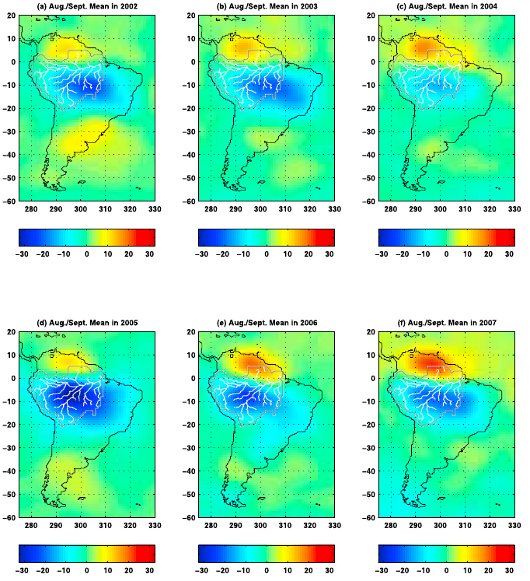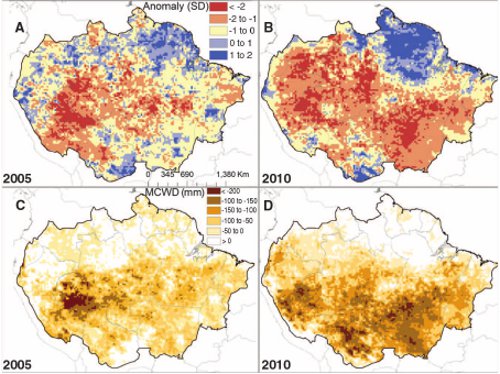
Continued from Part 2
2005 saw extremely warm sea surface temperatures in the tropical Atlantic, which was evident in the record coral bleaching in the Caribbean that year. But that wasn't the only negative consequence; the warm tropical Atlantic was also responsible for a one-in-a-100 year drought in the Amazon (see parts 1 & 2 for clarification).
Zeng (2006) examined the circumstances leading up to the drought, and found that it was a result of an extended dry period initiated by an El Niño in 2002-2003, followed by warming of the tropical Atlantic sea surface in 2004-2005. The decline in rainfall for the 2004-2005 drought was moderate, but because it followed on the heels of an El Niño, the rainforest had no decent wet spell in between the two dry periods in which to recharge. The loss of soil moisture in 2005, from this sequence of drying, was therefore quite dramatic.
The effect of the drying over the 2002-2005 period, near the end of the dry season, is well illustrated in the gravity satellite (GRACE) terrestrial water storage estimates below (dark blue indicates greater water deficit):

Figure 1 - GRACE-averaged August and September water storage changes (in centimeters of water) in South America in (a) 2002, (b) 2003, (c) 2004, (d) 2005, (e) 2006, and (f) 2007. A 2-step filtering scheme (P4M6 and 500-km Gaussian smoothing) is applied, as described in Chen (2009)
The exceptional drought saw a large scale die-off of trees, and the Amazon switched from being a carbon sink to a carbon source (more on this in a later post in this series).
Only 5 years after the 2005 drought, another extreme drought occurred in 2010. Much research on the latest event has yet to be published, however, both Lewis (2011) and Xu (2011) have established the 2010 drought was even more severe than that in 2005. Xu (2011) estimated the 2010 event affected an area 1.65 times as large as the 2005 drought.

Figure 2 - (A & B) satellite-derived standardized anomalies for dry-season rainfall for the two most extensive droughts of the 21st century in Amazonia. (C & D) The difference in the 12-month (October to September) MCWD from the decadal mean (excluding 2005 and 2010), a measure of drought intensity that correlates with tree mortality. (A) and (C) show the 2005 drought, (B) and (D) show the 2010 drought. Figure from Lewis (2011)
Now, given that climate models have predicted more intense episodes of Amazon drought as both the tropical Atlantic and Pacific continue to warm, it is notable that both factors may have been at play in the 2010 drought. Once again, sea surface temperatures in the Atlantic were well above normal (see Figure 3), and once again another mass coral bleaching episode occurred in the Caribbean.
Figure 3 - Map of global sea surface temperature anomaly (°C) for period May to October 2010 compared to baseline period 1951-1980. From NASA GISTEMP. A=sea surface cooling in tropical eastern Pacific (La Niña). B=warm anomaly in tropical Atlantic.
2010 also saw the end of a mild El Niño in the early part of the year and the El Niño is likely to have to have contributed to reduced rainfall over the December to February wet season (Foley 2002). Interestingly, despite the fact that two reasonably-sized La Niña events preceded the drought, bringing above average rainfall to much of the Amazon, the 2010 drought was still more severe than the 2005 episode. This tends to support the conclusions of Zeng (2006) who state that:
"Atlantic warming is also often not related to El Niño, and severe drought in the Amazon is more likely when they happen either near-simultaneously (such as 1997-98) or sequentially (such as during 2002-2005)"
It is unusual to have two such exceptional droughts so closely spaced together, and the droughts are consistent with climate model projections, where increased intensity and frequency of Amazonian drought, under global warming, leads to die-back of the rainforest. Although a peer-reviewed scientific paper detailing factors leading to the 2010 drought has not yet been published, it's likely that anomalously warm tropical sea surface temperatures were to blame.
Two datapoints, however, hardly constitute a trend, and waiting until one is evident will probably be too late if the worst-case scenarios prove correct. Another way to see how robust is the relationship between Amazon rainfall and the tropical sea surface temperature is to look back in time, at both the historical record and at paleoclimate proxies.
Next: The ITCZ, ENSO & the Amazon
Posted by Rob Painting on Thursday, 2 June, 2011
 |
The Skeptical Science website by Skeptical Science is licensed under a Creative Commons Attribution 3.0 Unported License. |